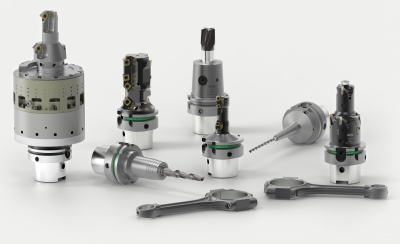
Connecting rods are highly stressed engine parts. To take account of downsizing and the reduction of CO2 emissions, connecting rods are also becoming increasingly lighter. This is achieved on the one hand through the use of high-strength and innovative materials, and on the other hand through modern production processes. This also changes the shape of the connecting rods and the variety of shapes increases. MAPAL offers the complete process for machining different types of connecting rods – whether on the transfer line or the machining center, as well as for wet or MQL machining.
When machining the connecting rod, the small connecting pin bore in particular is a challenge. Depending on the geometry, there are completely different drilling situations. For example, for various connecting rod forms, flat, deep and conical spherical surfaces or for existing forging noses. MAPAL has developed a modular tool concept for drilling from the solid with indexable inserts especially for this type of machining. Radially integrated, sintered indexable inserts each with four cutting edges are used here.
The placement of the indexable inserts and the chip flutes are adapted to the special requirements of the different drilling situations. The cutting materials are also adapted. Among other things, the new CVD coating from MAPAL is used, which combines the previously opposing high ductility and high wear resistance parameters and thus allows machining with significantly higher cutting speeds than before.
The tool body of the new tools is made of an optimized material with significantly less vibration. A central coolant supply in the holder ensures an optimum supply of coolant directly at the cutting edges. This means a significant increase in process reliability and stability during the machining of bores.
As a complete supplier, MAPAL not only offers the optimal tools, but also chucks perfectly tailored to the respective type of machining, including hydraulic power chucks or the HTC with slim contour for locations that are difficult to access, such as the oil bore. With the mechatronic actuating tool TOOLTRONIC, MAPAL also offers the appropriate solution for complex geometries, for example bores that are not circular or shaped bores with an oil groove. MAPAL thus offers customers the complete process with minimum tool changes, which is specially geared to the prevailing conditions in each case.
Contact Details
Related Glossary Terms
- chemical vapor deposition ( CVD)
chemical vapor deposition ( CVD)
High-temperature (1,000° C or higher), atmosphere-controlled process in which a chemical reaction is induced for the purpose of depositing a coating 2µm to 12µm thick on a tool’s surface. See coated tools; PVD, physical vapor deposition.
- coolant
coolant
Fluid that reduces temperature buildup at the tool/workpiece interface during machining. Normally takes the form of a liquid such as soluble or chemical mixtures (semisynthetic, synthetic) but can be pressurized air or other gas. Because of water’s ability to absorb great quantities of heat, it is widely used as a coolant and vehicle for various cutting compounds, with the water-to-compound ratio varying with the machining task. See cutting fluid; semisynthetic cutting fluid; soluble-oil cutting fluid; synthetic cutting fluid.
- ductility
ductility
Ability of a material to be bent, formed or stretched without rupturing. Measured by elongation or reduction of area in a tensile test or by other means.
- flat ( screw flat)
flat ( screw flat)
Flat surface machined into the shank of a cutting tool for enhanced holding of the tool.
- flutes
flutes
Grooves and spaces in the body of a tool that permit chip removal from, and cutting-fluid application to, the point of cut.
- machining center
machining center
CNC machine tool capable of drilling, reaming, tapping, milling and boring. Normally comes with an automatic toolchanger. See automatic toolchanger.
- wear resistance
wear resistance
Ability of the tool to withstand stresses that cause it to wear during cutting; an attribute linked to alloy composition, base material, thermal conditions, type of tooling and operation and other variables.
